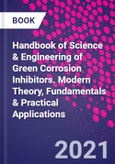Handbook of Science and Engineering of Green Corrosion Inhibitors: Modern Theory, Fundamentals and Practical Applications presents developments in green corrosion inhibitors and current applications. The book provides an overview of green corrosion inhibitors such as plant extracts, chemical medicines, natural polymers, synthetic green compounds, carbohydrates, amino acids and oleochemicals that can cost-effectively minimize corrosive damage. The book handles several compounds used as anticorrosive materials for different metals and alloys in a versatile corrosive environment. Sections address the fundamental characteristics of green corrosion inhibition and deal with the economic impact of corrosion and forms of corrosion, while also assessing and classifying corrosion inhibitors.
The book covers a broad range of applications in green corrosion inhibition and concludes with new emerging trends in corrosion protection such as high temperature corrosion and its protection and nanomaterials as corrosion inhibitors.
Please Note: This is an On Demand product, delivery may take up to 11 working days after payment has been received.
Table of Contents
SECTION 1 Overview of Corrosion and Green Corrosion Inhibitors
1. Corrosion: Basics and adverse effects
2. Forms of Corrosion
3. Basics and theories of corrosion: Thermodynamics and electrochemistry
4. Concept of green chemistry in corrosion science
5. Classification of corrosion inhibitors
SECTION 2 Corrosion Environments
6. Corrosion and corrosion inhibition in acidic electrolytes
7. Corrosion and corrosion inhibition in alkaline electrolytes
8. Corrosion and corrosion inhibition in neutral electrolytes
9. Corrosion and corrosion inhibition in sweet and sour environments
SECTION 3 Corrosion Investigation: Analysis and Assessment
10. Weight loss method of corrosion assessment
11. Electrochemical methods of corrosion assessment
12. Computational methods of corrosion assessment
SECTION 4 Synthetic Green Corrosion Inhibitors
13. Ionic liquids as green corrosion inhibitors
14. Green corrosion inhibitors from one step multicomponent reactions
15. Green corrosion inhibitors from microwave and ultrasound irradiations
16. Green corrosion inhibitors using environmental friendly solvents
SECTION 5 Natural Green Corrosion Inhibitors
17. Plant extracts as green corrosion inhibitors
18. Chemical medicines (drugs) as green corrosion inhibitors
19. Natural polymers as green corrosion inhibitors
20. Carbohydrates as green corrosion inhibitors
21. Amino acids (AAs) as green corrosion inhibitors
22. Oleochemicals as corrosion inhibitors
SECTION 6 Emerging Trends in Corrosion Protection
23. High temperature corrosion and corrosion inhibitors
24. Nanomaterials as corrosion inhibitors
Authors
Chandrabhan Verma Researcher, Department of Chemical and Petroleum Engineering, Khalifa University, Abu Dhabi, United Arab Emirates.Chandrabhan Verma, PhD, works at the Interdisciplinary Research Center for Advanced Materials, King Fahd University of Petroleum and Minerals, Dhahran, Saudi Arabia. He is a member of the American Chemical Society (ACS). His research interests mainly focus on the synthesis and design of environment-friendly corrosion inhibitors used for several industrial applications. Dr. Verma received his PhD degree from the Department of Chemistry at IIT?BHU, Varanasi, India and MSc degree in organic chemistry (Gold Medalist). Dr. Verma is the author of several research and review articles in peer-reviewed international journals. He has also received several national and international awards for his academic achievements.








